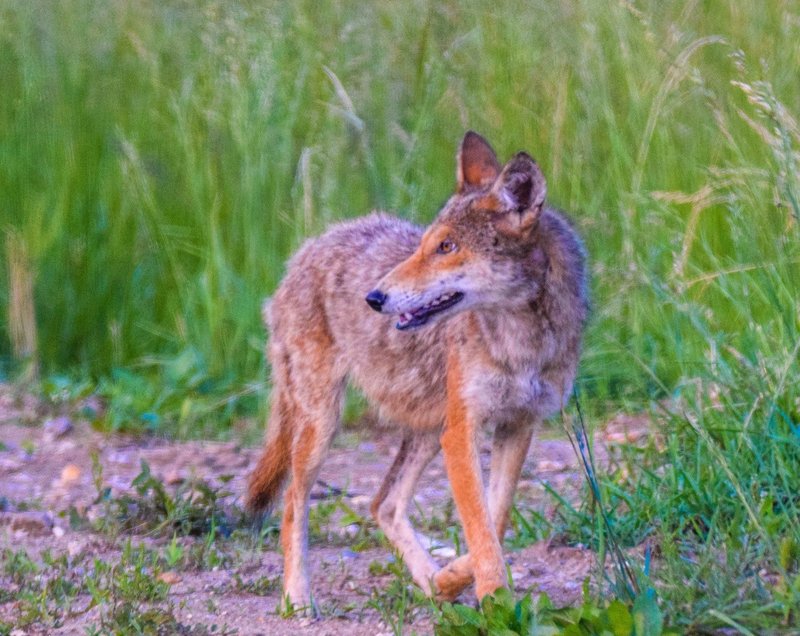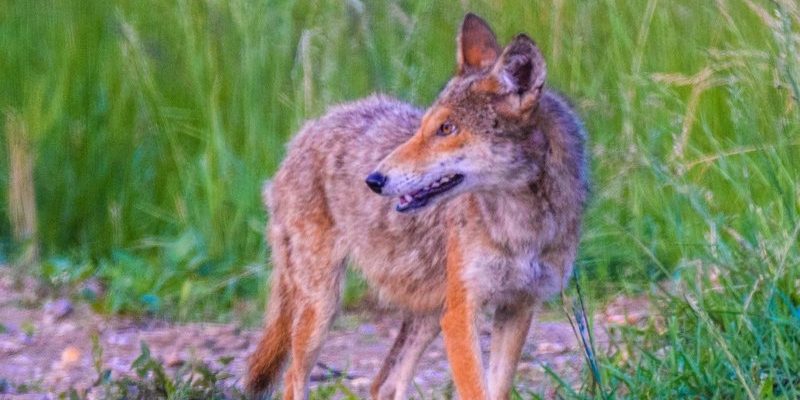
The coyote is one of those animals that seems to straddle the line between wild and familiar. Picture this: you’re out camping, and as the sun dips below the horizon, you hear a series of howls echoing through the trees. That intriguing sound comes from the clever and adaptable coyote. Found across North America, these creatures are often misunderstood and carry a certain mystique that keeps people curious. So, what exactly makes these canines so fascinating?
Coyotes are not only remarkable survivors; they’re also social animals with complex behaviors. You might be surprised to learn that these cousins of domestic dogs have a unique way of communicating, hunting, and even forming families. With their clever adaptations, they thrive in various environments, from bustling cities to quiet rural areas. So, let’s dive deeper into the world of the coyote and unravel its secrets!
Physical Characteristics of the Coyote
Coyotes have a distinct appearance that sets them apart from other canines. Typically, they stand about 20 to 24 inches tall at the shoulder and can weigh between 24 to 46 pounds. Their fur is usually a mix of gray, brown, and tan, helping them blend into their surroundings—a clever adaptation that keeps them safe from predators.
Their ears are upright and pointy, while their snouts are narrow and elongated. This allows them to hear prey scurrying underground or hiding in thick brush. The bushy tail, with a characteristic black tip, is commonly seen trailing behind them as they sprint through their habitats at speeds of up to 40 miles per hour. In fact, their agility and speed make them efficient hunters, capable of chasing down small mammals with ease.
Comparison with Other Canines
When you think of canines, you might picture domestic dogs or even wolves. Coyotes share some similarities with these relatives, but they also have unique traits that set them apart. While wolves typically hunt in packs and are larger, coyotes are more flexible in their social structures. They can live alone or in small family groups, which allows them to adapt to various environments.
Another interesting fact is that coyotes can interbreed with domestic dogs and sometimes even wolves, resulting in hybrid offspring. This adaptability in their genetics helps them thrive in changing environments—something that is critical for their survival as habitats shift due to human influence.
Habitat and Distribution
Coyotes are incredibly adaptable animals, which explains their wide distribution across North America. They can thrive in various habitats, including forests, grasslands, deserts, and even urban areas. In fact, many people don’t realize that coyotes often roam through city parks or neighborhoods, adapting their behavior to coexist with humans.
Their range has expanded over the years, and now they can be found in nearly every part of the continental U.S., Canada, and even parts of Central America. This adaptability is a testament to their resilience, as they can adjust their diets and behavior based on the available resources in their environment.
Urban Adaptations
You might be wondering how these animals survive in urban environments. Coyotes are resourceful creatures, employing a mix of instincts and learned behaviors to navigate city life. For instance, they often hunt small animals like rodents, rabbits, and even pets, which can become easier to catch in residential areas where they might feel less threatened.
They also scavenge for food in dumpsters or garbage bins, demonstrating their flexibility in finding meals. This adaptability has led to a growing population of coyotes in urban areas, creating a unique challenge for wildlife management and city dwellers who may encounter them more frequently.
Diet and Hunting Behavior
The diet of a coyote varies widely based on their location and the availability of food. Generally omnivorous, they enjoy a mix of small mammals, birds, fruits, and even carrion. Their opportunistic nature means they’re not picky eaters—if it’s edible, they’ll give it a go! This flexibility is a significant advantage, especially in environments where food sources fluctuate.
Coyotes are skilled hunters and often use teamwork when pursuing larger prey. They may hunt in pairs or family groups to corner their targets effectively. Their hunting techniques can include a combination of stealth, speed, and clever tactics, such as imitating the calls of other animals to lure unsuspecting creatures.
Social Structure and Communication
When it comes to social behavior, coyotes have a fascinating structure. They often live in small family units, which typically consist of a breeding pair and their offspring. These families work together to raise pups and hunt for food, showcasing a strong bond among members. You can think of them as a little pack, working together much like a close-knit family.
Coyotes have a rich vocal repertoire, which they use to communicate with each other. You might be familiar with their haunting howls, but they also bark, yip, and growl to express various emotions and warnings. These vocalizations reinforce social bonds and help coordinate group activities, especially during hunting or territorial disputes.
Reproduction and Lifespan
Coyote mating season typically occurs in late winter, around January and February. After a gestation period of about 63 days, females usually give birth to a litter of 4 to 7 pups in the spring. The pups are born blind and helpless, relying entirely on their parents for care. This period is crucial for their development, as both parents play a role in nurturing and teaching their young the skills they’ll need to thrive.
The pups start venturing outside their den at around three weeks old and will begin to explore further as they grow. By the time they reach about 6 months, they are usually ready to disperse and establish their territories. The average lifespan of a coyote in the wild is around 3 to 5 years, but some can live longer in less risky environments or in protected areas.
Challenges and Conservation
Despite their adaptability, coyotes face several challenges in today’s world. Habitat loss due to urban development, agriculture, and other human activities is one significant threat. Additionally, they are often viewed negatively, leading to hunting and trapping in some regions. While coyote populations are generally stable, their ability to thrive is tied to the health of their ecosystems.
Conservation efforts are crucial in ensuring these remarkable animals continue to roam freely. Education about coyotes can help reduce negative perceptions and promote coexistence, allowing humans and wildlife to share the landscape more peacefully. Understanding their behaviors, needs, and habits can foster a greater appreciation for these fascinating creatures.
Interesting Facts About Coyotes
| Fact | Details |
|---|---|
| Size | 20-24 inches at the shoulder; 24-46 pounds |
| Habitat | Forests, grasslands, deserts, urban areas |
| Diet | Small mammals, fruits, insects, carrion |
| Speed | Up to 40 miles per hour |
| Lifespan | Average 3-5 years, can live longer in protected areas |
FAQ
Are coyotes dangerous to pets?
Coyotes can pose a danger to small pets, especially if they are left outside unattended. They are natural hunters and may view small dogs and cats as prey. It’s essential for pet owners to supervise their pets during outdoor activities and provide a secure space where they can play safely.
Do coyotes hunt in packs?
Coyotes can hunt solo or in small family groups. They often use teamwork when hunting larger prey or when conditions require more strategic approaches. However, compared to wolves, their hunting groups tend to be smaller and more flexible based on food availability.
Can you keep a coyote as a pet?
Keeping a coyote as a pet is not advisable. They have specific needs that are challenging to meet in a household setting. Additionally, they are wild animals and can exhibit unpredictable behavior. If you’re interested in a canine companion, consider adopting a domesticated dog instead.
How can I coexist with coyotes in my area?
To coexist with coyotes, it’s crucial to avoid attracting them to your property. Secure trash and compost, avoid leaving pet food outside, and supervise pets. Additionally, educating yourself about coyote behavior can help alleviate fears and promote a more harmonious relationship.
What sounds do coyotes make?
Coyotes are known for their vocalizations, which include howls, barks, yips, and growls. Each sound can convey different messages. For example, howling can serve to communicate location, while yipping may indicate excitement or playfulness among pack members.
Where do coyotes live?
Coyotes are highly adaptable and can be found in a variety of habitats, including forests, grasslands, deserts, and urban areas. Their ability to thrive in diverse environments contributes to their widespread presence across North America.
What is their role in the ecosystem?
Coyotes play a significant role in their ecosystems by controlling populations of small mammals, which helps maintain a balanced environment. Their presence contributes to the health of their habitats, making them an essential part of the ecosystem.
Can coyotes interbreed with dogs?
Yes, coyotes can interbreed with domestic dogs and sometimes even with wolves. This ability to hybridize can result in unique genetic variations that may influence physical and behavioral traits. However, the offspring may exhibit mixed characteristics from both species.
What do coyotes eat in urban areas?
In urban environments, coyotes often adapt their diet to include small mammals like rats and rabbits, as well as human food sources such as garbage. Their opportunistic feeding behavior allows them to thrive in areas where traditional prey may be less available.
How do coyotes mark their territory?
Coyotes mark their territory through scents and vocalizations. They may urinate or defecate in specific areas to signal their presence to other coyotes. This behavior helps establish boundaries and prevents conflicts with neighboring groups.
What adaptations help coyotes survive in different environments?
Coyotes have several adaptations that contribute to their survival, including their omnivorous diet, agility, and social structures. Their flexible behavior allows them to thrive in diverse habitats, whether they’re navigating through forests or city streets.
Are coyotes solitary animals?
Coyotes can be either solitary or social, depending on the circumstances. They often live in family groups, but they can also be found alone, especially when hunting or exploring new territories. This flexibility in social behavior allows them to adapt to various situations.
How can we help conserve coyote populations?
Conservation efforts for coyotes involve promoting awareness and education about their role in ecosystems. Supporting local wildlife initiatives, protecting their habitats, and fostering coexistence can help maintain healthy coyote populations for future generations.

